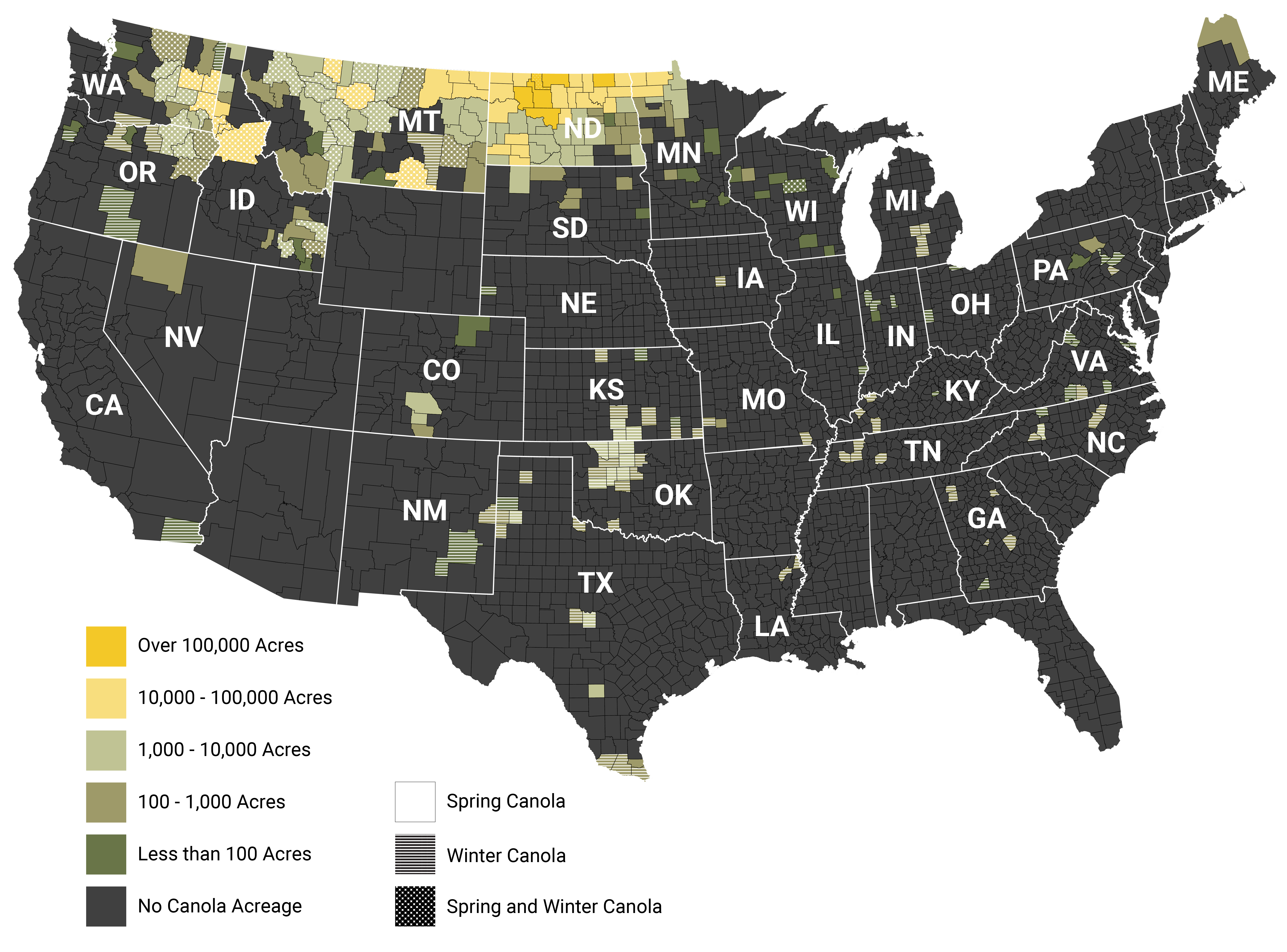Canola Quick Bytes
A supplement to U.S. Canola Digest
Capitol Hill

On June 21, the U.S. Environmental Protection Agency (EPA) released final volumes for biomass-based diesel and advanced biofuels under the Renewable Fuel Standard (RFS) for 2023, 2024 and 2025. It kept 2023 the same and slightly increased the next two years for a total of 2.82 billion, 3.04 billion and 3.35 billion gallons, respectively. The U.S Canola Association and Clean Fuels Alliance America expressed disappointment with the volumes because they limit the opportunity to maximize biofuel production to reduce greenhouse gas emissions from the transportation sector and do not reflect current production levels or capacity expansion plans of the oilseed crush and biofuel processing sectors. For example, EPA data showed that the U.S. biomass-based diesel (namely biodiesel and renewable diesel) market reached 3.1 billion gallons in 2021 and exceeded that level in 2022, which are higher levels than the RFS volumes set for 2023-24. The USCA and 75 stakeholders called for annually increasing the volumes by 500 million gallons per year in a letter to President Joe Biden as reported by The Progressive Farmer among other trade press.
The deal negotiated between President Biden and Congressional leaders to raise the debt limit has implications for the farm bill and annual agriculture appropriations. The debt limit deal expanded work requirements for certain recipients of the Supplement Nutrition Assistance Program, which is covered by the farm bill and a point of contention. Some members of Congress are signaling that more changes will be sought. The debt limit deal also set top-line funding levels for the annual federal appropriations process, seemingly paving the way for those bills to move forward and avoiding a government shutdown or the need for a Continuing Resolution. But House Republicans are seeking significant spending reductions that will make agreement with the Senate and White House more challenging.
The House agriculture appropriations bill is moving through the committee process. While the overall spending level provided by House Republicans for FY2024 is below FY2023, the National Institute of Food & Agriculture’s Supplemental and Alternative Crops program, which is the source of funding for the National Canola Research Program, is funded at $2 million, the same level as FY2023.
 Credit: Canola Council of Canada The USCA continues to educate key policymakers on canola production and works to ensure that the crop has a competitive presence in biofuel markets. USCA President Andrew Moore joined representatives of the American Soybean Association, National Oilseed Processors Association, Canadian Oilseed Processors Association and Clean Fuels Alliance America in a meeting with the California Air Resources Board to discuss flaws in its proposal to cap the amount of crop-based biofuels that can be used in the California Low-Carbon Fuel Standard program. Moore cited the growth and benefits of canola production as well as the potential for expanded winter canola. Tom Hance of the USCA and Alan Weber of Mark IV met with staff from the U.S. Department of Energy Bioenergy Technology Office to update them on canola production. This office steers federal research on biofuel feedstocks and focuses on identifying alternative feedstocks to support escalating biofuel production volumes. Hance also participated in a Clean Fuels Alliance America panel discussion on the farm bill, which also included discussion of the potential for expanded U.S. canola production.
Agronomy
 In its June 30 acreage report, the U.S. Department of Agriculture’s National Agricultural Statistics Service (NASS) estimated planted area of canola at a record high of 2.28 million acres in 2023 and harvest area is forecast at 2.24 million acres, both up 3 percent from last year. Planted area in North Dakota, the leading canola-producing state, is 1.9 million acres, up 6 percent from last year and the highest on record. Harvested area in the state is forecast at 1.88 million acres. Planted area in Washington at 155,000 acres is also a record high as well as the 151,000 acres forecast for harvest. Compared to last year, planted area is down more than 10 percent in Montana and Minnesota at 160,000 and 60,000, respectively, and more than 60 percent in Oklahoma and Kansas at 5,000 and 3,000. Both planted and harvested areas will be a record low in the latter two states with harvest acres forecast at 3,000 and 2,500, respectively. In its June 30 acreage report, the U.S. Department of Agriculture’s National Agricultural Statistics Service (NASS) estimated planted area of canola at a record high of 2.28 million acres in 2023 and harvest area is forecast at 2.24 million acres, both up 3 percent from last year. Planted area in North Dakota, the leading canola-producing state, is 1.9 million acres, up 6 percent from last year and the highest on record. Harvested area in the state is forecast at 1.88 million acres. Planted area in Washington at 155,000 acres is also a record high as well as the 151,000 acres forecast for harvest. Compared to last year, planted area is down more than 10 percent in Montana and Minnesota at 160,000 and 60,000, respectively, and more than 60 percent in Oklahoma and Kansas at 5,000 and 3,000. Both planted and harvested areas will be a record low in the latter two states with harvest acres forecast at 3,000 and 2,500, respectively.
One task farmers should never skip is a proper sprayer tank clean-out, says Agronomist Sean Senko of the Canola Council of Canada. Proper cleaning is crucial to prevent contamination and ensure effective pesticide application. Uncleaned tanks can lead from minor inconveniences to reseeding of a crop. Senko urges growers to use a lot of water when cleaning their tanks, follow proper cleaning procedures and regularly inspect their sprayer equipment.
 Credit: Deb Fortner Northern Canola Growers Association President Dan Marquardt told Red River Farm Network on its “Canola Minute” segment that canola planting has been wrapping up in his region and emergence has begun. He was enthusiastic about canola oil being approved by the EPA as an RFS feedstock for renewable diesel, noting the USDA is predicting 2.4 billion pounds of canola will be used for biofuel in 2023.
Pioneer Field Agronomist Kristie Sundeen has observed “spotty flea beetle pressure” in northern North Dakota, which may be due to insecticide resistance. As a result, she urges farmers to “stay on the high-rate end with foliar applications.”
Nutrition
 Credit: Canola Council of Canada A registered dietitian in Chatelaine magazine (Canada) debunked five myths about canola oil “to set the record straight … for once and for all.” She confirmed that the heart-healthy oil does NOT contain toxins or harmful levels of hexane or trans fat, nor causes inflammation due to omega-6 content. And while 95 percent of canola is genetically modified today, “there is no scientific evidence to back up [any] concerns” about biotechnology. So, should you use canola oil? “In a word, yes,” wrote Emily Szatrowski, R.D. “The social media hysteria on canola oil isn’t backed up by science. It’s a heart-healthy oil that is rich in omega-3s and low in saturated fat. It’s also neutral tasting and has a very high smoke point.”
Did you know canola oil has a qualified health claim authorized by the U.S. Food and Drug Administration? It states that consuming 1.5 tablespoons of canola oil daily in place of saturated fat may reduce the risk of heart disease. Bottlers can use this claim on their labels as well as in marketing materials.
Other Country News

Under the United States-Mexico-Canada Agreement, the U.S. government initiated a consultation with Mexico regarding its ban on genetically modified (GM) corn in certain foods, which may expand to other crops like canola. The Canadian government has joined the United States in support as Canadian agricultural groups say they are certain the ban on GM corn will lead to restrictions on other crops. The Canola Council of Canada applauds this move, citing that Mexico’s plant biotechnology regulations are not grounded in science and “risk stifling access to innovations that farmers need to contribute to food security challenges, address climate- related production issues, and remain competitive and profitable.” The Council has been advising Canadian officials on this topic as canola is Canada’s largest agri-food export to Mexico, valued at $1.6 billion in 2022.
The 16th International Rapeseed Congress of the Global Council for Innovation in Rapeseed and Canola and AOF (Australian Oilseeds Federation) will be Sept. 24-27, 2023 in Sydney, Australia. The Congress is held every four years and focuses on the advancement of global rapeseed/canola (Brassica napus) production and utilization. Abstracts to present there can still be submitted, covering any area of scientific and industrial research & development relating to Brassica napus and related Brassicaceae oilseeds.
Latest Industry News
 Agricultural commodity processors Bunge and Viterra announced a merger to create a global agribusiness company with increased diversification across geographies, seasonal cycles and crops. It will be one of the world’s largest grain companies, aiming to increase “operational efficiency while innovating to address the pressing needs of food security, efficiency for end-customers, market access for farmers, and sustainable food, feed and renewable fuel production,” according to Bunge CEO Greg Heckman. The merger is expected to close in mid-2024 and will create a “$34 billion agri-trading powerhouse,” reports Reuters. Agricultural commodity processors Bunge and Viterra announced a merger to create a global agribusiness company with increased diversification across geographies, seasonal cycles and crops. It will be one of the world’s largest grain companies, aiming to increase “operational efficiency while innovating to address the pressing needs of food security, efficiency for end-customers, market access for farmers, and sustainable food, feed and renewable fuel production,” according to Bunge CEO Greg Heckman. The merger is expected to close in mid-2024 and will create a “$34 billion agri-trading powerhouse,” reports Reuters.
High-protein canola varieties are being developed to meet growing demand for #biofuels, which is spurring new markets for #oilseed meal like #aquaculture #feed, notes Reuters. Corteva aims to launch high-protein canola for biofuel production and Botaneco is scaling up a 75 percent protein canola product for shrimp and salmon feed. The latter company is building a $224 million plant within three years to produce 100,000 tonnes of canola protein concentrate annually.
“The EPA’s approval of canola oil as a feedstock for renewable diesel and related biofuels gives canola farmers additional markets for surplus crops and the trucking industry more biofuel options,” said Tom Hance, director of the U.S. Canola Association, in Transport Topics. The U.S. Department of Agriculture predicts that canola oil use in biofuel production will jump to 2.15 billion pounds in 2022-23 and to 2.4 billion pounds in 2023-24. “Winter canola provides an opportunity for double cropping in which the grower produces three crops in two years on the same acreage,” Hance added. The Pacific Northwest, Great Plains and Southeast have areas favorable to planting canola in the fall, which enables another crop to be planted in the spring. Winter canola typically has 20-30% higher yields than spring canola.
 Growth trajectory for canola oil use in renewable diesel production was shattered with 322 million pounds in the month of March. This indicates that biofuel demand for canola is going to be higher than previously forecasted. Driven by increasing renewable energy targets and the need to reduce carbon emissions, this demand will create new opportunities for canola growers. Canola cash prices continue to increase and the future of canola oil as a sustainable biofuel feedstock looks favorable. Growth trajectory for canola oil use in renewable diesel production was shattered with 322 million pounds in the month of March. This indicates that biofuel demand for canola is going to be higher than previously forecasted. Driven by increasing renewable energy targets and the need to reduce carbon emissions, this demand will create new opportunities for canola growers. Canola cash prices continue to increase and the future of canola oil as a sustainable biofuel feedstock looks favorable.
The Northern Canola Growers Association (NCGA) will collaborate with North Dakota State University on research tours at the North Central Research Extension Center in Minot on Wed., July 19 and at the Langdon Research Extension Center on Thu., July 20. Each tour will provide valuable insights into the latest advancements and research on canola and other crops along with lunch. The NCGA will continue its tradition of hosting its popular golf tournament for canola growers and industry members at the Langdon Country Club on July 20 at 1:30 pm.
The NCGA will host another golf tournament for canola growers and industry members at the Minot Country Club on Mon., Aug. 7 at 1 pm. Participants will be treated to 18 holes of golf, a golf cart, supper at the club and prizes.
About the USCA
The USCA will host its fall board meeting in St. Louis, Mo., Oct. 29-31 in conjunction with the National Canola Research Conference and 2023 ASA, CSSA, SSSA International Annual Meeting. Register by Sept. 20 at acsmeetings.org/register.
 Want to see exactly where canola is growing in the United States? The USCA has a new canola acreage map by county on its website. Want to see exactly where canola is growing in the United States? The USCA has a new canola acreage map by county on its website.
Get social with us on Instagram, LinkedIn, Facebook, Twitter and YouTube.
Want to promote your products or services to canola producers and industry members? Visit our advertising pages to find specs, deadlines and rates to advertise in this monthly e-newsletter or on UScanola.com.
|




 In its June 30 acreage report, the U.S. Department of
In its June 30 acreage report, the U.S. Department of 


 Agricultural commodity processors
Agricultural commodity processors  Growth trajectory for
Growth trajectory for  Want to see exactly where canola is growing in the United States? The USCA has a new canola acreage map by county on its
Want to see exactly where canola is growing in the United States? The USCA has a new canola acreage map by county on its